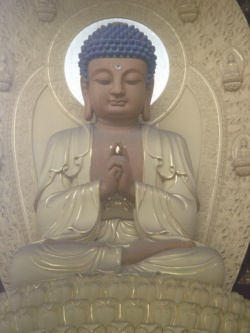Seng-ts'an
Seng-ts'an
Jianzhi Sengcan (J. Kanchi Sosan)
僧璨 (d. 606) (PY Sengcan; Jpn Sosan)
Also known as the Meditation Master Chien-chih. The third patriarch in the lineage of Zen (Ch'an) Buddhism in China. He studied the Zen teachings under the second patriarch, Hui-k'o. When Buddhism was suppressed by Emperor Wu (r. 560-578) of the Northern Chou dynasty, he hid himself on a mountain where he continued his practice. Seng-ts'an transferred the Zen teachings to Tao-hsin. He authored the work On Trust in the Heart.
Jianzhi Sengcan (Chinese: 僧璨) (died 606) (Wade–Giles: Chien-chih Seng-ts'an; Japanese: Kanchi Sosan) is known as the Third Chinese Patriarch of Chán after Bodhidharma and thirtieth Patriarch after Siddhārtha Gautama Buddha.
He is considered to be the Dharma successor of the second Chinese Patriarch, Dazu Huike (大祖慧可, Wade–Giles: Ta-tsu Hui-k’o, Japanese: Taiso Eka). Sengcan is best known as the putative author of the famous Chán poem, Xinxin Ming (W-G: Hsin-hsin Ming. Inscription on Faith in Mind, 信心銘).
Biography
The year and place of Sengcan’s birth is unknown, as is his family name.
Huike
It is said that Sengcan (old spelling: Tsang Tsan) was over forty years old when he first met Huike in 536 and that he stayed with his teacher for six years. (Dumoulin, p 97) It was Huike who gave him the name Sengcan (“Gem Monk”).
The Transmission of the Lamp entry on Sengcan begins with a koan-like encounter with Huike:
Sengcan: I am riddled with sickness. Please absolve me of my sin.
Huike: Bring your sin here and I will absolve you.
Sengcan (after a long pause): When I look for my sin, I cannot find it.
Huike: I have absolved you. You should live by the Buddha, the Dharma, and the Sangha.
There are discrepancies about how long Sengcan stayed with Huike. The Transmission of the Lamp records that he “attended Huike for two years” after which Huike passed on the robe of Bodhidharma and Bodhidharma’s Dharma (generally considered to be the Lankavatara Sutra), making him the Third Patriarch of Chan.
According to Dumoulin, in 574 the accounts say that he fled with Huike to the mountains due to the Buddhist persecution underway at that time. However, the Lamp records claim that after giving Sengcan Dharma transmission, Huike warned Sengcan to live in the mountains and “Wait for the time when you can transmit the Dharma to someone else.” as a prediction made to Bodhidharma (Huike’s teacher) by Prajnadhara, the twenty-seventh Chan ancestor in India, foretold of a coming calamity.
After receiving transmission, Sengcan lived in hiding on Wangong Mountain in Yixian and then on Sikong Mountain in southwestern Anhui. Thereafter, for ten years he wandered with no fixed abode.
Daoxin
He met Daoxin, (580-651) a novice monk of just fourteen, in 592. Daoxin attended Sengcan for nine years and received Dharma transmission when he was still in his early twenties.
Subsequently, Sengcan spent two years at Mount Luofu (Lo-fu shan, northeast of Kung-tung (Canton)) before returning to Wangong Mountain. He died sitting under a tree before a Dharma assembly in 606.
Dumoulin notes that a Chinese official, Li Ch’ang found Sengcan’s grave in Shu-chou in 745 or 746.
Sengcan received the honorary title Jianzhi 鑑智 (“Mirror Wisdom”) from the Tang dynasty emperor Xuan Zong.
Teachings
Sengcan, like Bodhidharma and Huike before him, was reputed to be a devotee and specialist in the study of the Lankavatara Sutra, which taught the elimination of all duality and the “forgetting of words and thoughts”, stressing the contemplation of wisdom.
However, McRae describes the link between Bodhidharma (and therefore Sengcan) and the Lankavatara Sutra as “superficial”. The link between this sutra and the “Bodhidharma school” is provided in Tao-hsuan’s Further Biographies of Eminent Monks where, in the biography of Fa-ch’ung he “stresses that Hui-k’o was the first to grasp the essence of the Lankavatara Sutra” and includes Sengcan as one who “discoursed on but did not write about the profound message of the Lankavatara Sutra. Due to the lack of authentic evidence, comments on Sengcan's teachings are speculative.
Writings
Although Sengcan has traditionally been honored as the author of the Xinxin Ming (W-G:Hsin-hsin Ming), most modern scholars dismiss this as unlikely and improbable.
Limited sources
The historical record of Sengcan is extremely limited. Of all the Chan patriarchs, Sengcan is the most ambiguous and the least known:
We have no certain information regarding Seng-ts’an. The course of his life lies in darkness.”
Further Biographies of Eminent Monks
The earliest recorded note naming Sengcan is in Further Biographies of Eminent Monks (645) (Japanese, Zoku kosoden; Pin-yin, Hsu kao-seng chuan) by Tao-hsuan (?- 667) where Sengcan is named, immediately after Huike’s name, as one of seven disciples of Huike in a biographical entry of the Lankavatara sutra master, Fa-ch’ung (587-665) No further information is given.
It was not until the Records of the Transmission of the Dharma-treasure (Sh’uan fa-pao chi), compiled about 710 and drawing on the stories in the Further Biographies of Eminent Monks, that a teaching “lineage” for Chan was created. Some have speculated that it was merely the fact that Sengcan’s name immediately followed Huike’s name in the latter work that led to him being named as the Third Patriarch of Chan.
Transmission of the Lamp
Therefore, the biography that follows is garnered largely from traditional biographies of Sengcan, mainly the Transmission of the Lamp.
Most of what is known about his life comes from the Wudeng Huiyuan (Compendium of Five Lamps), compiled in the early 13th century by the monk Puji at Lingyin Temple in Hangzhou. The first of the five records in the compendium is a text commonly referred to as the Transmission of the Lamp and it is from this text that most of the information about Sengcan is garnered.
However, it should be kept in mind that most modern scholars have some doubts about the historical accuracy of the Lamp records.
